Posts Tagged ‘cemetery’
-
Gone but not forgotten
“St. George Preca used to say that the cemetery is the biggest book and I had the opportunity to confirm that,” revealed a Capuchin friar who served as a custodian of the Addolorata cemetery for some years. Living among the dead, day and night, helped him to learn much about humanity and its weaknesses.
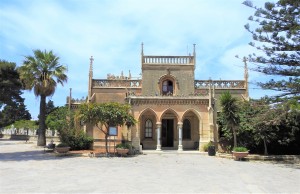 “The Capuchin friars were selected by the British authorities to administer this cemetery because they were loved by the locals. They had always been the ones who stood by the people during the worst moments and in situations which others avoided,” explained researcher Eman Bonnici.
“The Capuchin friars were selected by the British authorities to administer this cemetery because they were loved by the locals. They had always been the ones who stood by the people during the worst moments and in situations which others avoided,” explained researcher Eman Bonnici.“The British authorities hoped to attract people to bury their dead at the Addolorata cemetery. One of the best architects, Emanuele Luigi Galizia, was chosen to design this magnificent cemetery which took seven years to construct at the expense of £33,000. However, a well thought strategy was also required since this necessitated a considerable culture change within Maltese society.”
“Around 150 years ago, no one was buried in a cemetery except for those who died of contagious diseases or prisoners who were hanged. People buried their loved ones within the churches, chapels and crypts of their towns and villages to keep them close and within sacred grounds. Yet authorities considered this custom as a time bomb for some epidemic catastrophe. From time to time, outbursts of plague and cholera appeared on the islands, and it took days before the malady was identified. Case in points were the first plague victims of 1675 and 1813. Both were buried at Ta’ Ġieżu in Valletta, right at the capital city which was densely populated.”
“Initially, the Addolorata cemetery was intended to serve as a burial site for Catholics who were from Cottonera, Floriana and Valletta. As an incentive to start a new chapter in burial custom, those who had a private grave in any of these areas, were offered the possibility to choose a space in this cemetery and their grave would be dug for free. They were also given the privilege to use the cemetery’s church for burial rites and prayers before their loved ones were laid to rest. A further benefit consisted of a daily mass which was celebrated in this church and dedicated to all those who were buried within the cemetery.”
“Although a new law passed in 1863 prohibited further burials within churches, and the Addolorata cemetery was blessed and consecrated in 1869 to be ready for use, it was not that easy to convince the local population who had very strong beliefs related to death and burial customs. No one wanted to bury their dead in the new cemetery. Until one day, a poor woman from Naxxar who lived in Mosta, 64 year old Anna Magro, died at the general hospital, and since she had no relatives, she was the first one to be buried at this cemetery. Some time later, a number of people from Cospicua decided to accept the offer to have their own graves at the Addolorata, and from then, things moved on.”
The custodian’s role of the Addolorata cemetery was quite challenging. He had the responsibility of all the administration of the cemetery which included the registration of burials, the issuing of burial permits, the applications for new graves, the research for the public about the deceased and their graves, the maintenance of the cemetery and its church, the management of the workers, the distribuition of salaries which was still given out in money, the celebration of daily mass, and the hearing of confessions and spiritual advice.
“Originally the friars who acted as custodians were expected to spend the night at the cemetery. I spent around five years living at the cemetery together with a brother who was responsible to cook for me and to take care of the cemetery’s church. Although the brother resided at the cemetery for the whole year, friars alternated every week,” explained the friar.
“I was shocked when I was requested to become a cemetery custodian. I had studied philosophy and theology, and I had no idea whatsoever about the administration of a cemetery. However, my Provincial promised me that he would provide me with all the necessary assistance and so I accepted the role.”
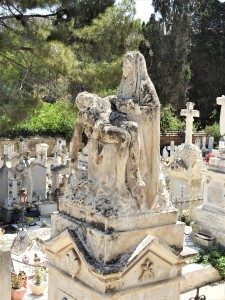 “Ironically, this work was a blessing in disguise! I had never imagined that the very place connected to death would fill my life with such significant experiences. A cemetery gets you in contact with all the levels of society, from the poorest to the richest, from the average person to the most successful. You learn a lot about humanity’s weaknesses and strengths, about love and hate, about repentance and revenge, about the excruciating suffering of illnesses and death. Ultimately, when the time came, it was actually difficult to leave this role.”
“Ironically, this work was a blessing in disguise! I had never imagined that the very place connected to death would fill my life with such significant experiences. A cemetery gets you in contact with all the levels of society, from the poorest to the richest, from the average person to the most successful. You learn a lot about humanity’s weaknesses and strengths, about love and hate, about repentance and revenge, about the excruciating suffering of illnesses and death. Ultimately, when the time came, it was actually difficult to leave this role.”“Some of my experiences at the cemetery are simply unforgettable. Some of them fill me with distate, others chill me to the bone, while a number of them remind me of the unexplainable power of prayer, love, hope and belief. At times, the pain and suffering which I had to deal with became unbearable and I had to seek out the comfort of the convent. More than the freezing cold of the night which reigned within those historical rooms, it was the distressful questions which people confronted me with, day after day, which affected me most.”
“Why is your God doing this to me?” asked a woman while carrying her sixth dead foetus for burial. “Her husband had brought the previous five and I had prayed with him and listened to his suffering. It was the first time that I was facing his wife and the news of yet another miscarriage was intensely sad and shocking. In moments like those, I asked God to guide me and he never failed to assist me. This is not the work of God but of nature, I told her. God would never do this to you! Give a name to each child and pray for each and to each one of them and you will find peace.”
“Around five years passed from this incident. Then, one day, the brother informed me that a couple needed to speak to me. I went out to meet them and they reminded me of their story. ‘I did just like you advised’, the woman told me. ‘And now we have him,’ she said as she reached out to a pram with a beautiful little baby boy inside.”
Stories poured out from the friar. He was still so emotional about them, as if they had just happenned the day before.
“On a very cold and rainy day in February, a smart and well-dressed man came to knock at my door. He gave me a grave number and I informed him that it was located in the common graves’ area. The man asked me to accompany him with a car to see this grave and I drove him there.”
“As soon as I pointed out the grave, the man jumped out of the car, fell to his knees on the ground and began to cry out for his mother’s forgiveness. ‘Forgive me mum! It was not my fault!’ he repeated over and over again while the heavy rain rammed on his back. I felt so distraught for him but eventually I managed to pull him back in the car and help him to calm down.”
“He told me the story of how forty years before, his mother and his wife had a quarrel, and his wife threatened to leave him if he ever got in contact with his mother again. She even forbid him from going to his mother’s funeral, calling him twice at his office on that day to confirm that he had abided to her rules. ‘We have four children and I did not want to mess up my family,’ he informed me, leaving me dumbfounded.”
It was very compelling to witness such hate and thirst for revenge, even after death.
“One day I was asked to give advice to a very affluent man who came to buy a plot to construct a chapel in the cemetery. He was insisting that only he and his wife, their children and their offsprings could be buried in this chapel, leaving out all his sons’ wives, explicitly named in a contract. I told him that this was very uncharitable on his part but he was resolute. I warned him that on knowing about this, his sons would curse him and his wife but he brushed this comment off, ensuring me that he was leaving them all well off.”
“The old couple died and they were buried in the chapel. All went well until one of his sons was widowed. He came to us to make arrangements for his wife’s burial in the family chapel. As soon as he identified himself, I braced myself for trouble since it was clear that he knew nothing about his parents’ decision. He could not believe his ears when we informed him that he could not bury his wife in the chapel. He got so angry and swore so badly, cursing his parents over and over again, that we had to threaten him with the police. Matters worsened further when he realized that this condition affected also all his brothers. He called them all and they came to the cemetery in a frenzy, infuriated at this unexpected news.”
“No matter how much they insisted with us to eliminate this condition, there was nothing we could do. The woman had to be buried in a new grave. All the other brothers bought a new grave too. Their parents’ richly adorned and expensive chapel now lies abandoned and in ruins.”
Nowadays the cemetery is no longer administered by the Capuchin friars.
(This article was published in the SENIOR TIMES – NOVEMBER issued with The Times of Malta on 15th November 2018)
-
WALKING WITH THE DEAD
“As soon as they saw us approaching with our horses, some shop owners hurried to close their doors in order to show us that we were not welcome,” remembered 74 year old, Alfred Mifsud. “This happenned mostly in the villages of Ħal-Kirkop and Safi, and in other areas of northern Malta. It was more a reaction to the sense of disgust which people felt towards our job rather than because of any superstitious fear that we could attract death to their doorstep. In fact, those who did let us in their shops to drink a cup of tea, had a number of reserved cups for us, since other clients would refuse to use them.”
In the old days, it was hard to be an undertaker. Work started from the early hours, when it was still dark, as it took long to prepare the horses and the carriages, and then to drive to church. The deceased was placed in a coffin and was generally carried on the shoulder, from his house to the chapel or church where mass was celebrated in the early morning, so that those who attended, could go to work soon after. In the meantime, the undertakers would stay outside, waiting to carry the coffin to the cemetery.
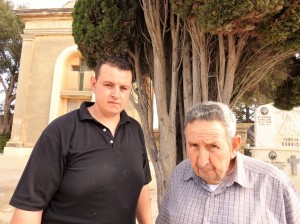 “By that time, after travelling the long road on a hard seat in the cold, we would be yearning for a cup of tea. Yet there were moments when where it not for the kindness of the church’s sacristan, we would be bound to wait for hours before we could drink something warm.”
“By that time, after travelling the long road on a hard seat in the cold, we would be yearning for a cup of tea. Yet there were moments when where it not for the kindness of the church’s sacristan, we would be bound to wait for hours before we could drink something warm.”Certainly, this was a minor discomfort when considering what the rest of the job entailed.
“People might think that undertakers will eventually get used to death and will become numb to the pain which it brings with it. However, they are definitely mistaken because we are often saddened by the suffering, especially when children are somehow involved. How can you remain indifferent when you see parents burying their child or when you hear the cry of the young ones when they see their mum or dad being hauled underground?”
A shudder ran through me and I wondered how anyone could withstand to do such a job.
“You learn to accept death as part of the circumstances of life and consider your job just like any other. You do your duty as best as you can in order to see that everything will run smoothly and that your client is served well.”
When Alfred was twelve years old, he was already assisting his dad, who was also an undertaker, to prepare the deceased for burial. He also gave a hand to other undertakers by helping them out in cemeteries. Even as a child, this work did not upset him and he was never afraid of dead people or burial grounds.
“Our family has been doing this work for more than a century now. It was Lukardu Pace, my father’s uncle, who started a career in this sector, by carrying the dead in funeral carriages. After he died in a traffic accident, my father Fidiel, who is now 93 years old, took over this job, and he introduced us in this work. Eventually it was only me who became a funeral carriage driver besides being an undertaker. However my brothers opened another business which is related to funerals.”
As Alfred began to show me some old photographs of the different funeral carriages that were available at the time, I realized that although death does not differentiate between the rich and the poor, nonetheless, affluent persons still insisted to distinguish themselves from others until the very end.
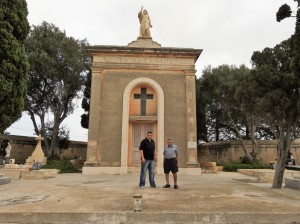 “Prosperous families used the carriage known as ‘tal-prima’ which was very elaborate and richly designed with golden sculpture. It was made of mahogany and it was drawn by four black horses that were adorned with feathers and an elegant pall. Then there was ‘tas-sekonda’ carriage which was made of cheaper painted wood and was accompanied by two black horses. A carriage painted in white and decorated with flowers was utilized to carry dead children and teenagers. In this case, the black horses were dressed with a white pall which was embellished with golden embroidery. ”
“Prosperous families used the carriage known as ‘tal-prima’ which was very elaborate and richly designed with golden sculpture. It was made of mahogany and it was drawn by four black horses that were adorned with feathers and an elegant pall. Then there was ‘tas-sekonda’ carriage which was made of cheaper painted wood and was accompanied by two black horses. A carriage painted in white and decorated with flowers was utilized to carry dead children and teenagers. In this case, the black horses were dressed with a white pall which was embellished with golden embroidery. ”Alas, there was no pomposity reserved for the destitute ones, especially if they had no family. The same thing applied to those who were in trouble with the Church.
“In the past, the Church had a much greater influence on the Maltese society. One was expected to receive the holy communion at least once a year, and a ticket known as ‘bulettin’ was given to those who adhered to this regulation. Those who did not, were not considered as part of the Church, and if they died, they became known as ‘ta’ bla preċett’. No priest would accompany them for their burial, and obviously, no mass would be celebrated. They would simply be carried away in a carriage and were buried in a particular section in the cemetery which was reserved for such people. I remember my father narrating how in such cases, the families of the deceased would insist with him to go and collect the dead relative during the night so that the neighbours will not see what was happenning. Then he would go and wait behind the cemetry’s door in order to be the first to enter once it opens, and hasten the burial before other people are around.”
Alfred remarked that the tradition to celebrate a funeral mass started from the 1970s. Before that period, the family would only organize a short function prior to the burial. In fact, during this time, he used to manage to attend to three or four burials in a day. This was not anymore possible, once funerals included also a longer mass.
“Along my 50-year career, I have witnessed many changes with regards to funerals. Amongst these, I remember many instances where the deceased was accompanied not only by family and friends, but also by members of a religious confraternity. There were also those who paid nuns and orphans from convents of charity in order to attend to their funerals.”
Interesting information kept pouring out as Alfred recalled his long experience in this work. Although happily married to Mary, he still reminisces the difficulty in his youth to find a partner, as many girls considered his work repulsive. Many years have passed from then on and the situation has somehow mitigated. However, Albert, his 29 year old son, who has followed his father’s career, told me that he had the same problem too.
 “I have been fascinated by my father’s work since I was five. Somehow, I was never afraid to help him out in cemeteries and I preferred to be with him than to go to school. Yet, I can understand the discomfort that other people who are not involved in this sector might feel in these circumstances.”
“I have been fascinated by my father’s work since I was five. Somehow, I was never afraid to help him out in cemeteries and I preferred to be with him than to go to school. Yet, I can understand the discomfort that other people who are not involved in this sector might feel in these circumstances.”“By now, I have learnt to take everything in stride, even when I notice some people making superstitious signs at me or at our hearses. There are moments when people make it embarassingly evident that they are uncomfortable with my presence. I remember clearly a particular instance when a person was so perturbed when he saw me waiting behind him in a queue, that he refused to take the rest of the money from the salesgirl and ran out of the shop.”
Just like his father, Albert admitted that when death is always on the order of the day, this job could engulf you with turmoil. Yet throughout these years, he was diligently coached by his father in order to learn how to protect himself from excessive grief, particularly by recognizing the significance of his work in alleviating this burden from the mourning family. Nevertheless, the fear of death is difficult to overcome, even when one faces it so many times.
“Instead of helping you to take death lightly, probably this work might make you perceive the end in a more dreadful way, since you know clearly what awaits you,” Albert said as he smiled nervously.
(This article was published in ‘Man Matters’ Supplement issued with The Times of Malta dated 19th December 2015)
-
The Chinese who remained in Malta

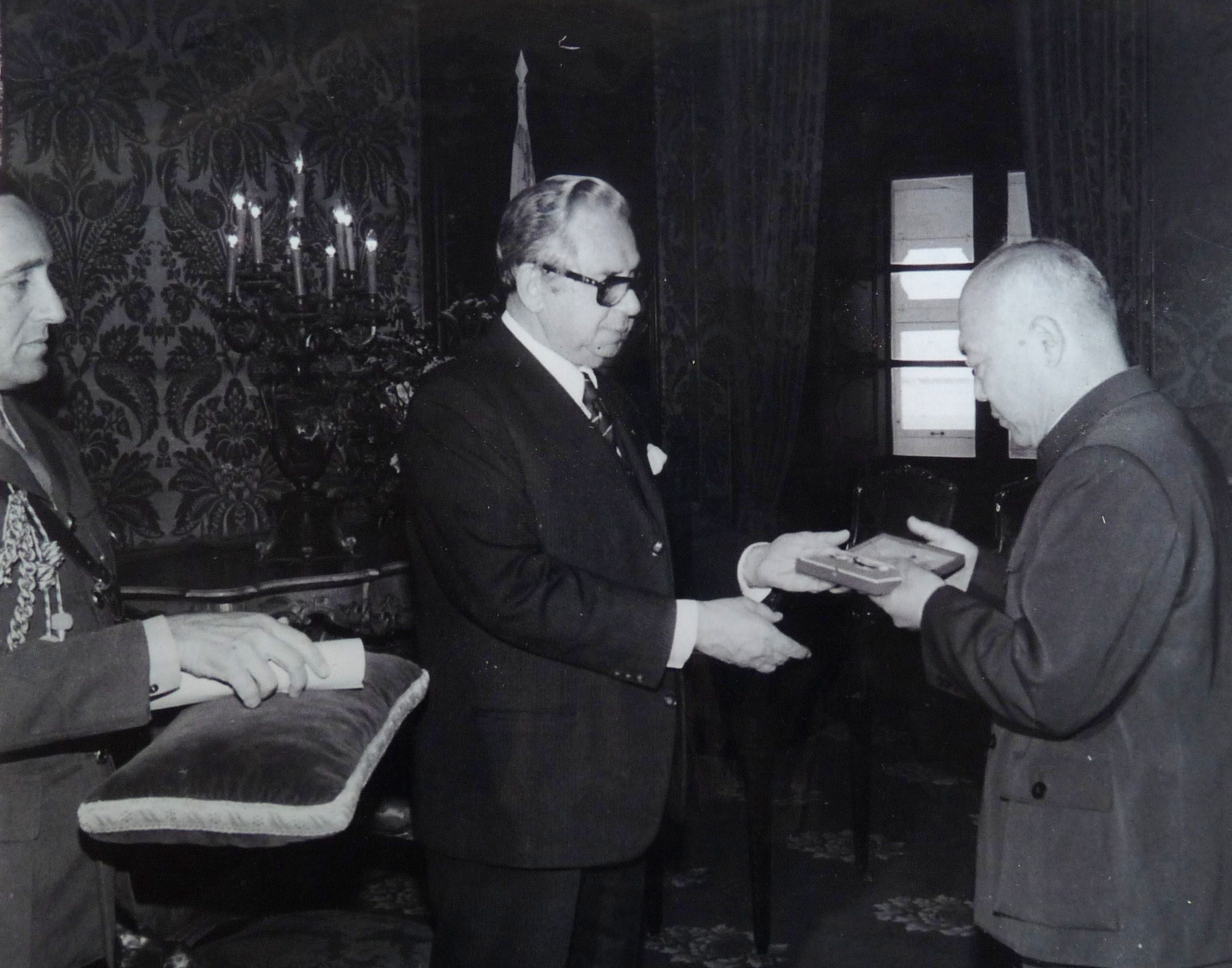

Last Sunday, many of us went to visit the cemeteries which are located around our islands in order to pay our respects to our dead relatives and friends.
Many of us took with them a beautiful bunch of coloured and fragrant flowers which we left on the cold tombs made of yellowish stone or of icy white or dark black marble. Apart from showing love and respect, this gesture seemed to try to inject life where there was not.
Others have also dedicated some time to clean the tombs by removing the weeds or by changing an old photograph with a new one.
Thousands of red candles were lit so that their humble flame might accompany the soft prayers that were said for the deads’ souls.
Many people had tears in their eyes. Even those whom their relatives had died a long time ago but still feel emotional at this loss.
I find these death rituals very interesting, particularly when I observe how society continues to keep dear to its heart those who have died; sometimes even by continuing to treat them as if they were still alive.
Whilst I walked along the paths of the Addolorata cemetery, I could notice all these customs. A pang of sadness crept into my heart when I noticed some bare tombs whom no one seemed to have visited. However, a closer look at the dates written on these tombs indicated that probably those particular families had ended and therefore nobody remained to visit.
The tombs of Xu Huizhong and Gu Yanzhao
I arrived in front of the tombs which I went to visit: those of Xu Huizhong and Gu Yanzhao; two Chinese engineers who died in our country whilst they were working on Dock Number 6 in Malta. Xu had died accidentally whilst Gu was deceased due to an illness.
Their photos looked at me and I greeted them in name of their country and in name of mine. As a sign of respect, I put a bunch of white and yellow chrysanthemums on their tombs according to Chinese tradition which symbolizes sadness and grief. Then, according to my culture, I prayed to God to give them eternal rest.
I remember that when I asked some Chinese individuals regarding why these two persons had been buried in Malta and were not taken back to their country, they informed me that this had been their relatives’ decision. This is because, according to Chinese culture, these individuals had to be buried in the country for which they were working because that was the only way how they could rest in peace: for they had to be present on the same land when the project on which they were working was successfully finished.
Notwithstanding this, I still wondered what these persons’ relatives might have felt when they had to allow those whom they had loved, to be buried in a foreign country, and so far away.
An honorary medal of the Republic of Malta for engineer Xu Huizhong
I continued to think about this and so I decided to talk to ex-Labour Minister, Reno Calleja, who in 1979 was sent by Malta Prime Minister, Duminku Mintoff in order to present an Honorary Award of the Republic of Malta to the family of engineer Xu Huizhong. This honour was given to this man after he died tragically on 16th March 1979 whilst he was working at the construction of a new dock in our country.
“That was a day which I will never forget!” revealed Calleja as soon as we started to discuss this matter. “More than that, I must say that personally, I consider that moment as the most salient one in my political career. I cherish it that much because on that day, I felt that I was becoming part of my country’s history; where Malta was presenting a very significant award to a foreign worker after his death, because he had lost his life whilst he was helping our country.”
An agreement between Malta and China
Calleja remembers clearly that period when China had agreed to help our country to regain its economic strength.
“In those years, even China was a relatively poor country but it chose to help Malta all the same. It is during such moments that one can see the true friendship of a country: when it helps you in times when it is not so strong itself,” insisted Calleja.
“The wise decision that Mintoff had made, when in 1972 he visited China with a Maltese delegation in order to meet Mao Zedong, after Nixon had did so too about a month before, was very much appreciated. And thanks to this choice, the Maltese people are still enjoying the benefit of this friendship, now that China has become a very rich country.”
Many Chinese workers help in the construction of Dock Number 6
“Apart from giving us financial support, the Chinese people helped us a lot by sending us many technical workers in order to attend to various important projects in Malta, including the construction of Dock Number 6,” Calleja continued to explain.
“These Chinese workers have worked along with the Maltese labourers and our people got enriched in the principles of work as they learnt about the Chinese culture from these people. It was a culture of a people of great humility with vast enterprise together with a devotional sense of duty towards their own country. The enthusiasm shown by the Chinese workers as they worked with quality and precision, even when they were doing this for another country, inspired the Maltese to behave like them. And if the Chinese labourers were working with much dedication in order to make their country proud, the Maltese labourers were getting busy so that their country would be thankful to them,” Calleja said.
“When Dock Number 6 was ready, I attended to the opening ceremony and I swear that I noticed many workers cry when they saw Mintoff’s face alight with satisfaction for the good job that everyone had made.”
Reno Calleja goes to China in order to present the Medal
Unfortunately, this fantastic narrative has also its negative side; including the instance of the death of engineer Xu.
“In 1979, I was invited to visit China in order to represent the Malta-China Friendship Society. When I advised the Prime Minister about this, he requested me to go to China in April because he had something in mind,” remembered Calleja.
“After a fortnight, Mintoff informed me that he had decided to give a Medal of the Republic of Malta on an honorary basis after his death to engineer Xu Huizhong and I was recommended to take it with me on my visit to China. Soon ex-President of Malta, Anton Buttigieg, organized a ceremony wherein he invited the ex-Ambassador of China in Malta, as a representative of the Government of the People’s Republic of China in order to present him with this medal. Then this medal was handed to me and I took it with me to China.”
Here, Calleja showed me some photographs of those distinguished moments.
“A very big ceremony was organized at the great Congress Hall in Shanghai in order to present this medal to engineer Xu’s family. For this event, I prepared a speech in Maltese which was translated in Chinese by a Maltese student. This student was Clifford Borg-Marks whom today is the Ambassador of Malta in China.”
“During this ceremony, I had the privilege to meet engineer Xu’s widow and his children who all appreciated very much this honourable award that our country had given them. However, I can never forget the sad face of his widow who thanked me respectfully and said nothing more.”
From then on, Calleja has kept in contact with Xu’s family.
“Regrettably, a year after I met her, Xu’s widow died of grief. Yet her children kept in contact with me and they came to Malta in order to visit their father’s grave. Now, Xu’s grand-daughter has informed me that when she grows up, she would like to become an engineer like her grandpa.”
Chinese traditions
An interesting fact is that the Chinese people do not celebrate the death rituals during our same period. Furthermore, they have more than one ceremony related to paying respect to their dead.
Qingming Festival
Among these traditions, there is the Qingming Festival or Tomb Sweeping Day. This festival takes place on the 4th or the 5th April, according to the traditional lunar calendar.
During this festival, the people remember and honour their ancestors by praying, cleaning tombs, re-painting calligraphy on tombs, burning incense or offering food, tea, drinks and other accessories on the tombs. Moreover, on this day, some people may carry willow branches with them or hang them on their doors in order to ward off the evil spirits which may roam around on Qingming.
Since the Qingming takes place with the beginning of the Spring season, these celebrations usually include also family outings and kite flying. Some farmers start ploughing their fields on this day.
The Ghost Festival
During this festival which takes place in August, people will pay respects to all deceased whether young or old. Some of the activities which take place during the Qingming are also undertaken throughout the Ghost Festival; including the offering of food and the burning of incense.
Other celebrations could include the releasing of miniature paper boats and lanterns on water. This ritual is intended to direct the lost ghosts and spirits to their resting places as some people believe that on this day, the deceased will visit the living.
(This article is a translation of the Maltese original version which was published in the series KOBOR IL-MALTI (Part 25) in Torċa dated 9th November 2014)
-
LOOK OUT, BEHIND YOU
GREZZJU VELLA accompanied me up to the roof of St Gregory’s Church, and pointed out the area where the opening to his macabre revelation had been discovered. Boldly he even ventured into the three passageways but he refused to approach the skeletons lying before us in solemn silence.
Since 1969, a series of secret passages accidentally discovered by a 16-year-old Grezzju within the historic church of St Gregory which was rebuilt in the 15th Century, have posed an unsolved riddle. Inside were a heap of skeletons – a shocking discovery that left a deep and troubling impression on the young man. After reporting the find, he decided to avoid speaking about the incident, until now, at age 58, he felt ready to open up to me about it.
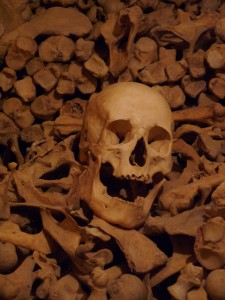 Among the skeletons were some medieval coins, a Byzantine cross, a metal net which historians identified as of a type that used to be worn under a suit of armour, and a shoe-sole. No one knows why these remains were in these tunnels or who the skeletons belonged to. Initially it was believed that they were the unfortunate victims of a Turkish or pirate attack, of the type that were quite frequent in the days of when and after the church was built. However in 1978, nine years after this discovery, these remains have undergone paleopathological studies, producing the first report on medieval bones found in Malta (1). Both the evidence of soil within some bones and the wide discrepancy in the total number of bones pertaining to various parts of the body indicated that probably these were exhumed from some sort of cemetery. Most of the skeletons were very well preserved, possibly because they were confined in a completely covered and well ventilated passage. Among the bones, 19 male skulls and 24 female skulls were discovered, the youngest belonging to a child of about 8 years. It was not possible to arrive at a conclusion about the cause of death of these individuals but the appearance of the bones suggested that these people had died within a short time from each other. Eventually the experts who conducted this analysis, Seshadri Ramaswamy and Joseph Leslie Pace, came to the conclusion that most likely, one of the passages was used as an ossuary. Tentatively they also proposed the idea that these bones could have been moved to this location when some graves were cleared in order to make space for the original extension of the church (2).
Among the skeletons were some medieval coins, a Byzantine cross, a metal net which historians identified as of a type that used to be worn under a suit of armour, and a shoe-sole. No one knows why these remains were in these tunnels or who the skeletons belonged to. Initially it was believed that they were the unfortunate victims of a Turkish or pirate attack, of the type that were quite frequent in the days of when and after the church was built. However in 1978, nine years after this discovery, these remains have undergone paleopathological studies, producing the first report on medieval bones found in Malta (1). Both the evidence of soil within some bones and the wide discrepancy in the total number of bones pertaining to various parts of the body indicated that probably these were exhumed from some sort of cemetery. Most of the skeletons were very well preserved, possibly because they were confined in a completely covered and well ventilated passage. Among the bones, 19 male skulls and 24 female skulls were discovered, the youngest belonging to a child of about 8 years. It was not possible to arrive at a conclusion about the cause of death of these individuals but the appearance of the bones suggested that these people had died within a short time from each other. Eventually the experts who conducted this analysis, Seshadri Ramaswamy and Joseph Leslie Pace, came to the conclusion that most likely, one of the passages was used as an ossuary. Tentatively they also proposed the idea that these bones could have been moved to this location when some graves were cleared in order to make space for the original extension of the church (2).Within the passageways, Grezzju took me back to that fateful day in 1969.
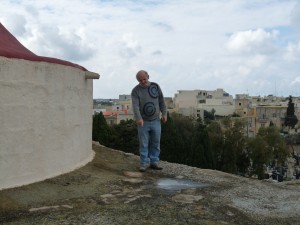 “I had never heard any rumours about the existence of secret passages built round the dome of St Gregory’s church in Żejtun. If I had known, I would certainly have kept away from the roof of the church upon which one day I was thoughtlessly scratching away – a scratching that revealed the sealed opening.
“I had never heard any rumours about the existence of secret passages built round the dome of St Gregory’s church in Żejtun. If I had known, I would certainly have kept away from the roof of the church upon which one day I was thoughtlessly scratching away – a scratching that revealed the sealed opening.I was helping with the maintenance of the wooden apertures of the old church, together with my uncle Carmelo Spiteri and a fellow worker Ċikku Zammit, when Dun Ġwann Palmier asked us to take a look at the roof as it was leaking rain-water. Up we went, walking around the ancient dome which is thought to be one of the oldest domes in Malta. The views up there are beautiful… at least if you avoid looking at the nearby cemetry crowded with ghostly white-marbled tombs. I don’t know why but I always had an instinctive fear of the dead and death itself, a strong gut-feeling which I could not suppress, not even today.
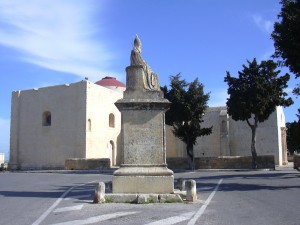 I was probably just trying to kill time as I sat down and scraped off at a narrow fracture on the roof whilst the others were inspecting the rest of the area in order to identify the parts where grouting was needed. To my surprise, the more I hacked at the crack, the more it widened, till at one point I decided to throw a pebble inside to see whether I could hear it fall into the church below. However oddly enough, when I threw it in, I heard it falling nearby and I realized immediately that there could be some sort of structure within the dome itself. I called the others who at first did not take much notice of what I was doing, but when it became evident that there was an ashlar block, my uncle urged me to carve it out. Curiously I slashed off the remaining sealant and on taking the block away, we found that it had been acting as a perfect wedge to lock the opening to a chamber.
I was probably just trying to kill time as I sat down and scraped off at a narrow fracture on the roof whilst the others were inspecting the rest of the area in order to identify the parts where grouting was needed. To my surprise, the more I hacked at the crack, the more it widened, till at one point I decided to throw a pebble inside to see whether I could hear it fall into the church below. However oddly enough, when I threw it in, I heard it falling nearby and I realized immediately that there could be some sort of structure within the dome itself. I called the others who at first did not take much notice of what I was doing, but when it became evident that there was an ashlar block, my uncle urged me to carve it out. Curiously I slashed off the remaining sealant and on taking the block away, we found that it had been acting as a perfect wedge to lock the opening to a chamber.We decided to stop and called for Dun Gwann to come and have a look. The discovery left him puzzled because although he had been responsible for the upkeep of the church for some time, he had never known about this chamber, although he had heard folk tales of hidden passages located in the vicinity of the church. Soon after we were also joined by Ġanmarì Debono, the sacristan of the church, who also had no idea where this opening could lead to. Since I was the youngest and the leaner one, it was decided that I should be lowered down with a rope so that I could see what was inside.
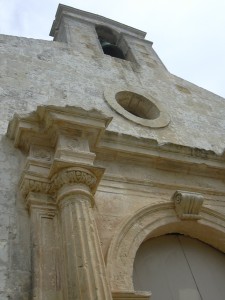 They tied a rope around my waist and gave me a box of matches to find my way through in the darkness. As soon as I touched the floor I lit the first match and in the few seconds of light that it gave me, I managed to see that I was in some sort of passage. With the aid of the fleeting weak light of one match after another, I walked a distance of about 30 feet, but there was much more space in front of me. I hesitated and nervously turned back, alerting the others that the area covered much more than we had originally thought.
They tied a rope around my waist and gave me a box of matches to find my way through in the darkness. As soon as I touched the floor I lit the first match and in the few seconds of light that it gave me, I managed to see that I was in some sort of passage. With the aid of the fleeting weak light of one match after another, I walked a distance of about 30 feet, but there was much more space in front of me. I hesitated and nervously turned back, alerting the others that the area covered much more than we had originally thought.It was then that Dun Gwann had a premonition that I had found the enigmatic passages that people used to narrate stories about. Strangely enough, some years earlier some people had tried to unveil the truth about these tales by trying to open through a side of the dome, but they had not found anything. Dun Gwann told me that the passage would probably lead all the way round the dome, and he calmly encouraged me to go back and find out. He assured me that I would be safe as I was securely tied to the rope, so I plucked up some courage and went back in.
The remaining matches accompanied me along the passage where it abruptly seemed to end, when I suddenly found myself treading on a mass of objects scattered beneath my feet. I felt around with my hands and my fingers came to something resting on the wall in front of me. The darkness was complete while I fumbled at the object to try and understand what it was. My fingers ran over two gaping holes… and then I felt what seemed to be a row of teeth! To my utter shock I recognized that I was holding a skull!
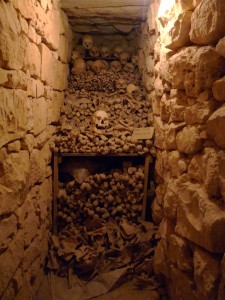 I will never forget the sound of crunching bones as, having let go of the skull with a scream, I turned on my heels and raced back to the faint safety of the light where I had come from. Distraught and agitated I told the others what I had found and left the rest to them.
I will never forget the sound of crunching bones as, having let go of the skull with a scream, I turned on my heels and raced back to the faint safety of the light where I had come from. Distraught and agitated I told the others what I had found and left the rest to them.The incident devastated me at the time, as the fear of anything associated with death that had always lurked within me came out with a vengeance and engulfed me in a state of shock. An ugly rash broke out over my skin and it took me months to calm down completely. I remember my mum Michelina being enraged at my uncle who had allowed me to go down there even though he was aware of my phobia.
From then on I rarely even mentioned this incident to anyone. And even though news of the discovery of the secret passages was quite a sensation back in 1969, I did not reveal to any of my school friends that I had played such an important role in their exposure, I don’t know why. Maybe I simply wanted to be left alone with the hope that one day I would forget this terrible experience. Yet I never really succeeded in doing this, and even though my parents and my brother are buried in the church’s cemetry, for many years I could not ever convince myself to return there. Though I live in the vicinity of the church itself, I’ve tried my best to always avoid going near it. It makes me feel uneasy.
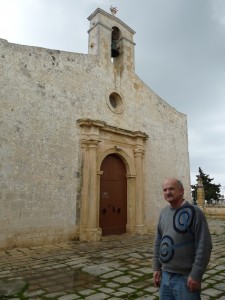 This is the first time that I have been in these passages since that fateful day 42 years ago… and this is the first time I’ve told the story in its entirety to someone from the media. But today I was determined to settle this long-standing debt that has ruled my life for so long and come to terms with the experience. It’s time to move on.”
This is the first time that I have been in these passages since that fateful day 42 years ago… and this is the first time I’ve told the story in its entirety to someone from the media. But today I was determined to settle this long-standing debt that has ruled my life for so long and come to terms with the experience. It’s time to move on.”And with that, we moved out of the haunting passages. Each year, after Easter, a votive traditional procession culminates at this magnificent church which is endowed with distinguished culture, history and architecture. But few of the faithful who congregate for the procession probably know of the enigma waiting to be resolved, save for the few who remember hearing about the discovery all those years ago. A recently formed NGO bearing the name of Wirt iż-Żejtun has vowed to investigate further this unsolved mystery. Maybe finally the time will come for these souls to tell the story and then forever rest in peace.
References
(1) Ramaswamy S & Pace J. L, 1979. The medieval skeletal remains from St. Gregory’s Church at Żejtun (Malta) – Part 1 Paleopathological Studies in Archivio Italiano Di Anatomia E Di Embriologia, Vol. LXXXIV – Fasc. 1.
(2) Ramaswamy S & Pace J. L, 1980. The medieval skeletal remains from St. Gregory’s Church at Żejtun (Malta) – Part 2 Anthropological Studies in Archivio Italiano Di Anatomia E Di Embriologia, Vol. LXXXV – Fasc. 1.
(Note: An edited version of this article was published on FIRST magazine - Issue: April 2011)
Travelogue
Archives
| M | T | W | T | F | S | S |
|---|---|---|---|---|---|---|
| « Jan | ||||||
| 1 | 2 | 3 | 4 | 5 | 6 | 7 |
| 8 | 9 | 10 | 11 | 12 | 13 | 14 |
| 15 | 16 | 17 | 18 | 19 | 20 | 21 |
| 22 | 23 | 24 | 25 | 26 | 27 | 28 |
| 29 | 30 | |||||
Recent Posts
- A MATTER OF FATE
- MALTA’S PREHISTORIC TREASURES
- THE MAGIC IS IN THE DETAIL
- THE SELLING GAME
- NEVER FORGOTTEN
- Ġrajjiet mhux mitmuma – 35 sena mit-Traġedja tal-Patrol Boat C23
- AN UNEXPECTED VISIT
- THE SISTERS OF THE CRIB
Comments
- Pauline Harkins on Novella – Li kieku stajt!
- admin on IL-KARNIVAL TRAĠIKU TAL-1823
- Albert on IL-KARNIVAL TRAĠIKU TAL-1823
- Martin Ratcliffe on Love in the time of war
- admin on 24 SENA ILU: IT-TRAĠEDJA TAL-PATROL BOAT C23